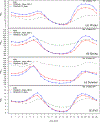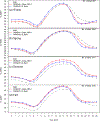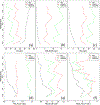Description and evaluation of the Community Multiscale Air Quality (CMAQ) modeling system version 5.1
- PMID: 30147852
- PMCID: PMC6104654
- DOI: 10.5194/gmd-10-1703-2017
Description and evaluation of the Community Multiscale Air Quality (CMAQ) modeling system version 5.1
Abstract
The Community Multiscale Air Quality (CMAQ) model is a comprehensive multipollutant air quality modeling system developed and maintained by the US Environmental Protection Agency's (EPA) Office of Research and Development (ORD). Recently, version 5.1 of the CMAQ model (v5.1) was released to the public, incorporating a large number of science updates and extended capabilities over the previous release version of the model (v5.0.2). These updates include the following: improvements in the meteorological calculations in both CMAQ and the Weather Research and Forecast (WRF) model used to provide meteorological fields to CMAQ, updates to the gas and aerosol chemistry, revisions to the calculations of clouds and photolysis, and improvements to the dry and wet deposition in the model. Sensitivity simulations isolating several of the major updates to the modeling system show that changes to the meteorological calculations result in enhanced afternoon and early evening mixing in the model, periods when the model historically underestimates mixing. This enhanced mixing results in higher ozone (O3) mixing ratios on average due to reduced NO titration, and lower fine particulate matter (PM2.5) concentrations due to greater dilution of primary pollutants (e.g., elemental and organic carbon). Updates to the clouds and photolysis calculations greatly improve consistency between the WRF and CMAQ models and result in generally higher O3 mixing ratios, primarily due to reduced cloudiness and attenuation of photolysis in the model. Updates to the aerosol chemistry result in higher secondary organic aerosol (SOA) concentrations in the summer, thereby reducing summertime PM2.5 bias (PM2.5 is typically underestimated by CMAQ in the summer), while updates to the gas chemistry result in slightly higher O3 and PM2.5 on average in January and July. Overall, the seasonal variation in simulated PM2.5 generally improves in CMAQv5.1 (when considering all model updates), as simulated PM2.5 concentrations decrease in the winter (when PM2.5 is generally overestimated by CMAQ) and increase in the summer (when PM2.5 is generally underestimated by CMAQ). Ozone mixing ratios are higher on average with v5.1 vs. v5.0.2, resulting in higher O3 mean bias, as O3 tends to be overestimated by CMAQ throughout most of the year (especially at locations where the observed O3 is low); however, O3 correlation is largely improved with v5.1. Sensitivity simulations for several hypothetical emission reduction scenarios show that v5.1 tends to be slightly more responsive to reductions in NO x (NO + NO2), VOC and SO x (SO2 + SO4) emissions than v5.0.2, representing an improvement as previous studies have shown CMAQ to underestimate the observed reduction in O3 due to large, widespread reductions in observed emissions.
Conflict of interest statement
Competing interests. The authors declare that they have no conflict of interest.
Figures


















References
-
- Altimir N, Kolari P, Tuovinen J-P, Vesala T, Back J, Suni T, Kulmala M, and Hari P: Foliage surface ozone deposition: a role for surface moisture?, Biogeosciences, 3, 209–228, doi:10.5194/bg-3-209-2006, 2006. - DOI
-
- Anderson DC, Loughner CP, Diskin G, Weinheimer A, Canty TP, Salwitch RJ, Worden HM, Fried A, Mikoviny T, Wisthaler A, and Dickerson RR: Measured and modeled CO and NOy in DISCOVER-AQ: An evaluation of emissions and chemistry over the eastern US, Atmos. Environ, 96, 78–87, doi:10.1016/j.atmosenv.2014.07.004, 2014. - DOI
-
- Appel KW, Bhave PV, Gilliland AB, Sarwar G, and Roselle SJ: Evaluation of the Community Multiscale Air Quality (CMAQ) model version 4.5: Sensitivities impacting model performance; Part II - particulate matter, Atmos. Environ, 42, 6057–6066, doi:10.1016/j.atmosenv.2008.03.036, 2008. - DOI
-
- Appel KW, Chemel C, Roselle SJ, Francis XV, Sokhi RS, Rao ST, and Galmarini S: Examination of the Community Multiscale Air Quality (CMAQ) model performance over the North American and European Domains, Atmos. Environ, 53, 142–155, doi:10.1016/j.atmosenv.2011.11.016, 2012. - DOI
-
- Appel KW, Gilliland AB, Sarwar G, and Gilliam RC: Evaluation of the Community Multiscale Air Quality (CMAQ) model version 4.5: Sensitivities impacting model performance; Part I - ozone, Atmos. Environ, 41, 9603–9615, doi:10.1016/j.atmosenv.2007.08.044, 2007. - DOI
Grants and funding
LinkOut - more resources
Full Text Sources
Other Literature Sources
Research Materials
